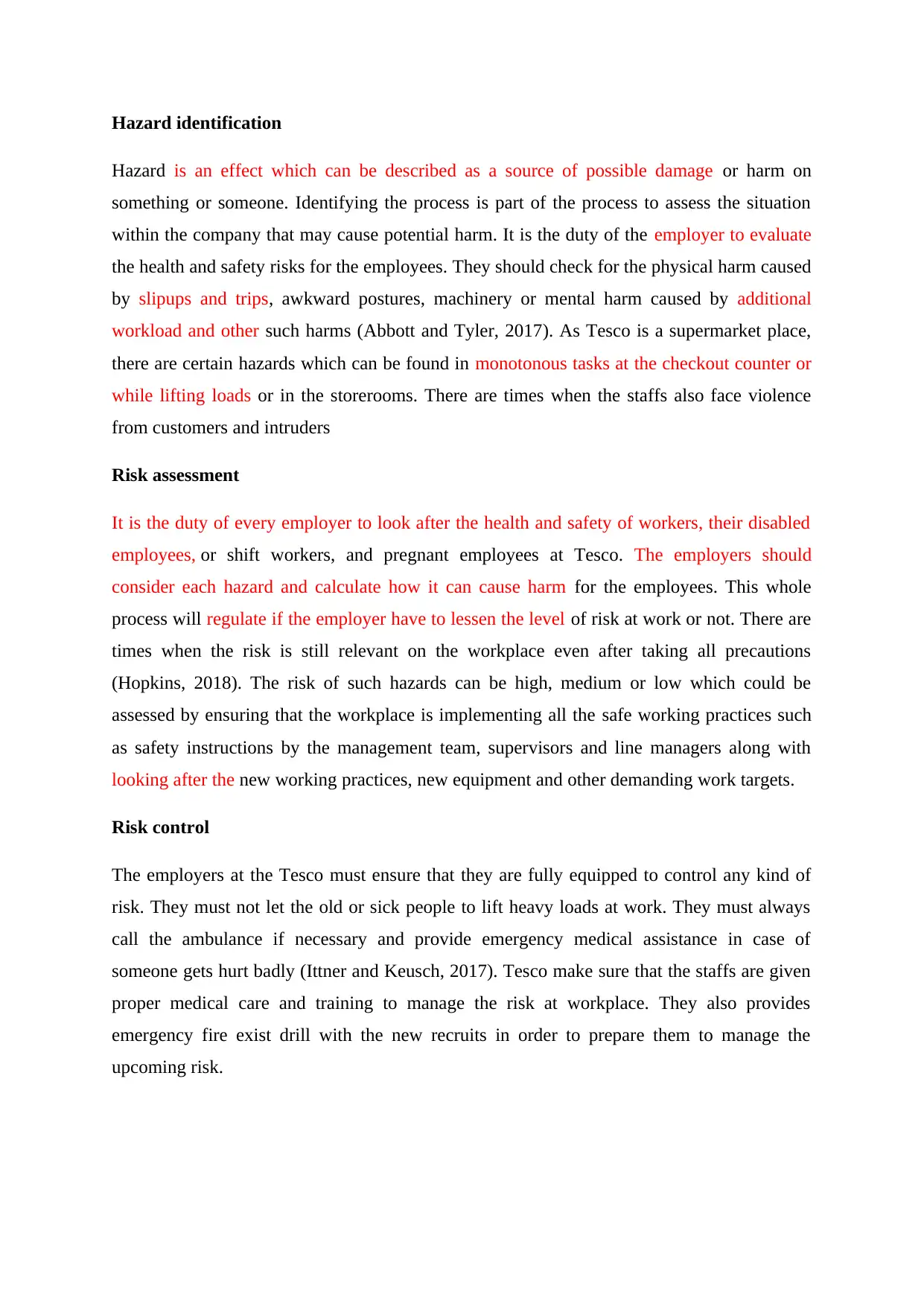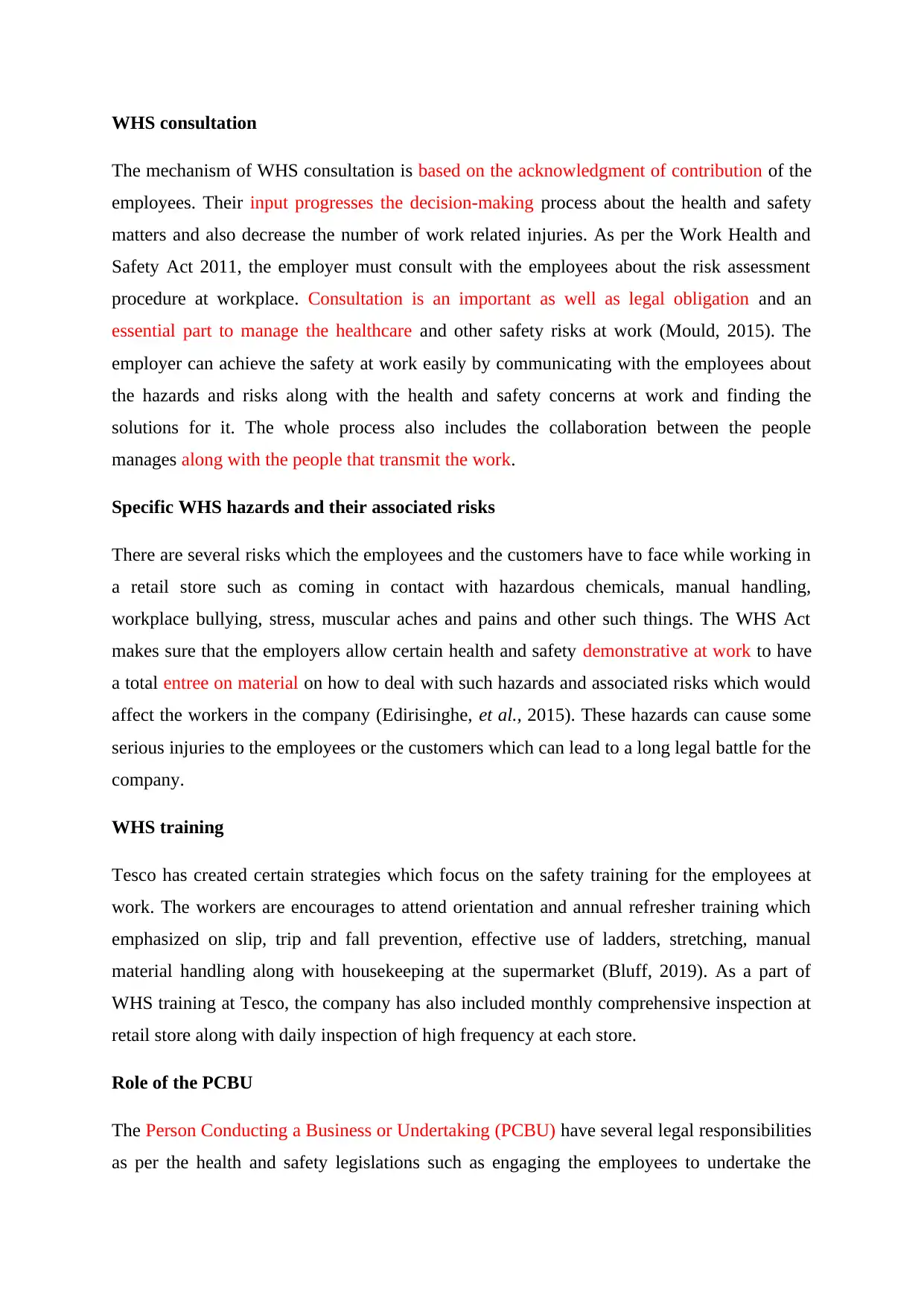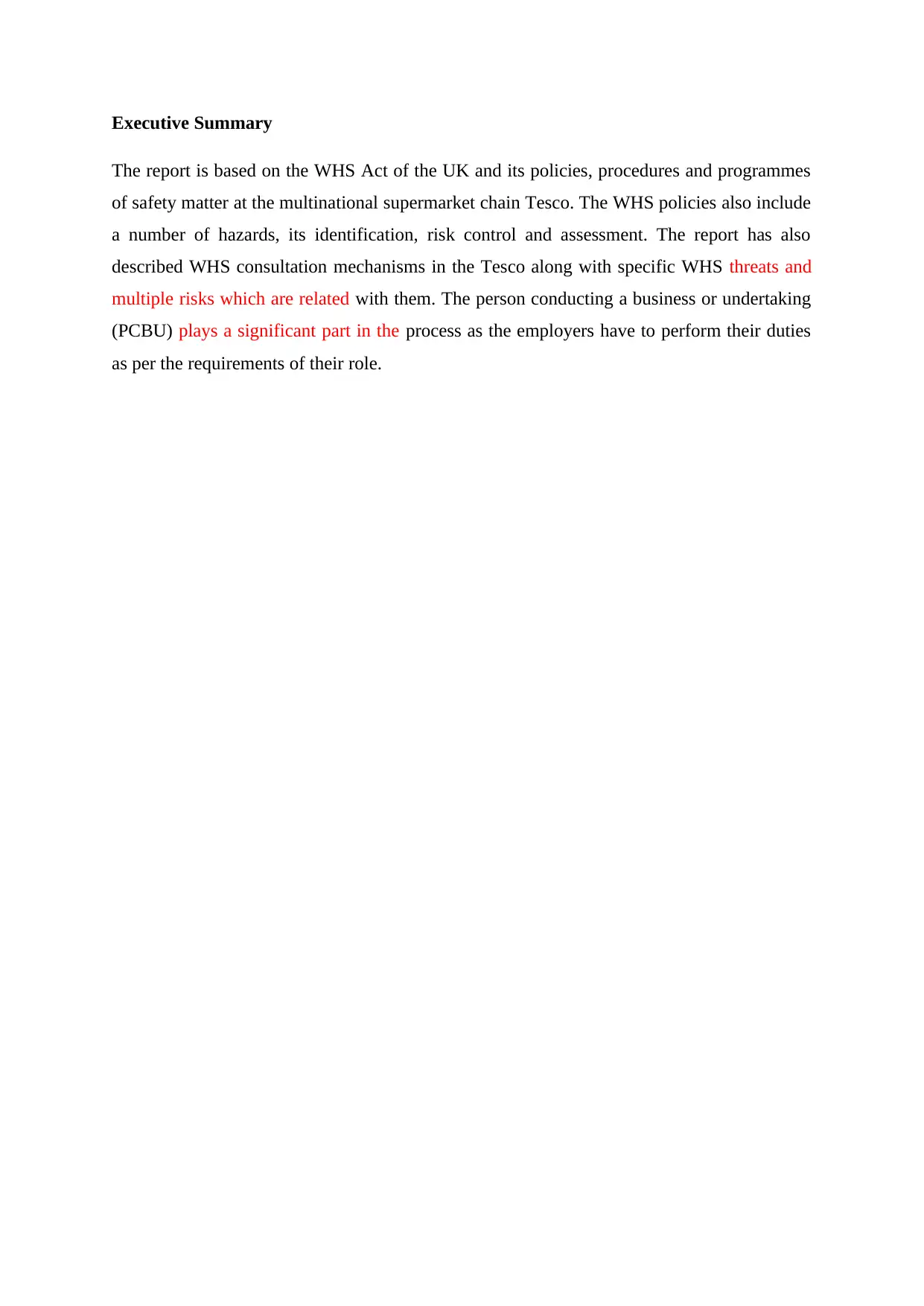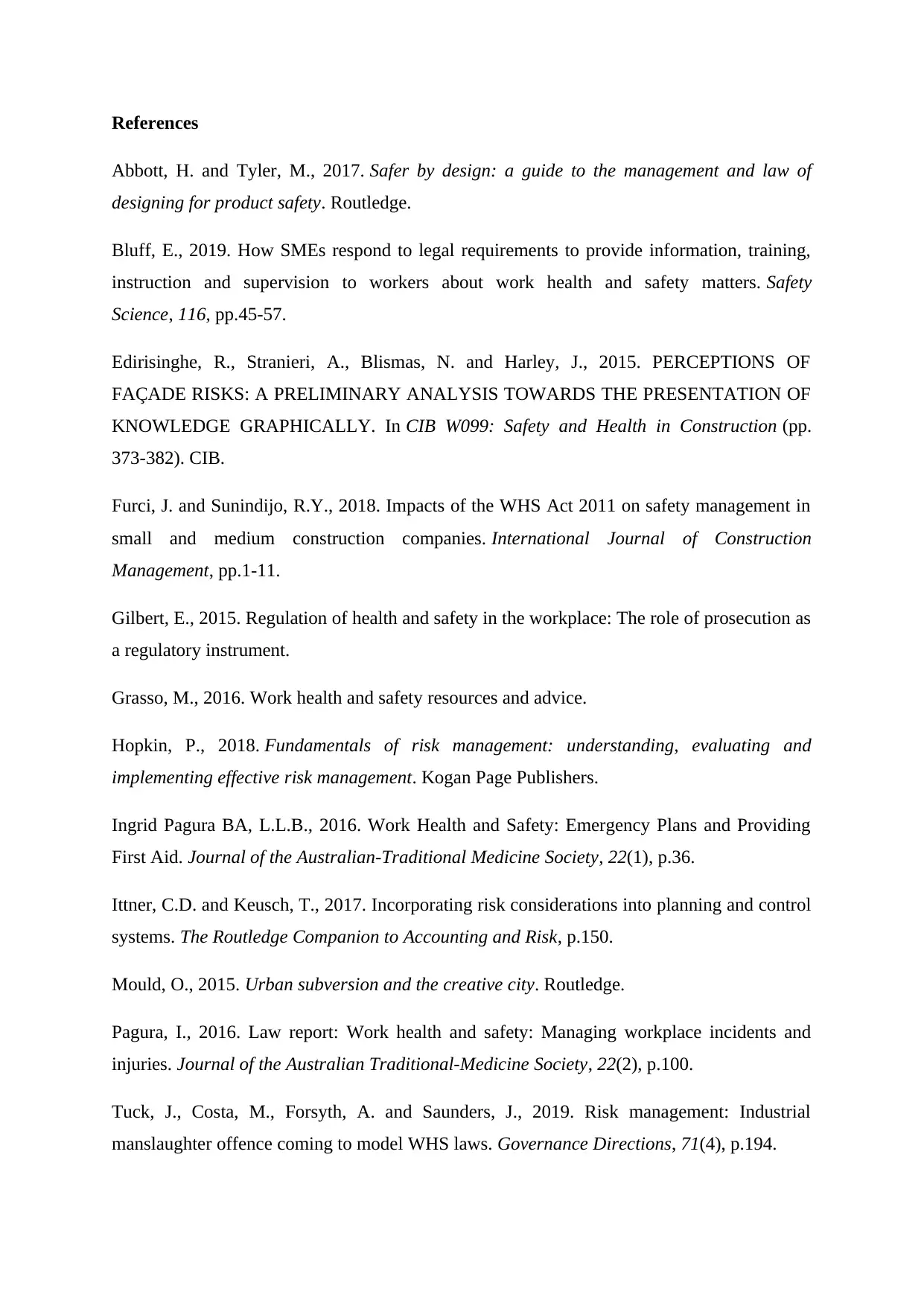BSBWHS401 Assessment 1: Tesco's WHS Policies, Procedures, and Programs
VerifiedAdded on 2023/01/12
|9
|2142
|94
Report
AI Summary
This report provides a comprehensive analysis of workplace health and safety (WHS) policies, procedures, and programs implemented by Tesco, a multinational supermarket giant. It delves into key aspects such as hazard identification, risk assessment, and risk control measures, highlighting how Tesco addresses potential dangers in its operational environment. The report also examines WHS consultation processes, ensuring employee involvement in safety matters, and explores specific WHS hazards and associated risks within a retail setting. Furthermore, it investigates WHS training initiatives and clarifies the role of the Person Conducting a Business or Undertaking (PCBU) in maintaining a safe workplace. The report concludes with recommendations for management to enhance workplace processes, ultimately aiming to improve safety standards and promote a secure environment for both employees and customers. This report is a valuable resource for students studying BSBWHS401, providing practical insights into real-world WHS practices.

Policies, procedures and programs on safety matters at work
Paraphrase This Document
Need a fresh take? Get an instant paraphrase of this document with our AI Paraphraser

Introduction
Safety at work is a very important aspect of managing a business. There are several national
policies which has been established and implemented for improving the health as well as
safety of the employees at work across every sector (Furci and Sunindijo, 2018). The Work
Health and Safety Legislation in the UK suggest a range of duties for the employers which
must be followed to protect the health, safety and wellbeing of the employees working in a
business environment. This report will over the policies, procedures and programmes of
safety matter at the supermarket giant Tesco.
Tesco is a one of the largest multinational groceries and general merchandise retailer in the
world. It is primarily based in UK, with its headquarters in Hertfordshire. Tesco was founded
in 1919 and over the years it has started to operate its business in more than 60 countries with
6,569 stores across the world. As of the year 2017, the total number of employees working in
Tesco sums upto 460,000 employees. Tesco is also very famous for looking after the
healthcare and safety of its employees as well as customers. The company prefers to conduct
the business with utmost concern and safety of the people and maintaining a proper Safety
Standards within the organisation. Tesco applies number of WHS acts in the company such
as Work Health and Safety Regulation 2011, Work Health and Safety (Hazardous Manual
Tasks) Code of Practice 2015 and other such regulations.
WHS policies, procedures and programs
Tesco is a giant supermarket organisation that implements number of policies and
programmes for maintaining the healthcare and wellbeing at work for the employees. The
company provides provision in the work related safety and health along with the fire safety
engineering by the specialists in the Group People Safety Department. The safety
professionals like Members of the Institute of the Institute of Occupational Safety and Health
are allotted to manage the risk of policies of the business and procedures which has the ability
to affect people (Grasso, 2016). Tesco also follows certain code of practice which is approved
under the WHS act. There and number of codes such as Work Health and Safety (How to
Manage Work Health and Safety Risks) Code of Practice 2015, Work Health and Safety
(Work Health and Safety Consultation, Co-operation and Co-ordination) and many other such
codes that guide the company to achieve the standard of health under the WHS Act and WHS
Regulations.
Safety at work is a very important aspect of managing a business. There are several national
policies which has been established and implemented for improving the health as well as
safety of the employees at work across every sector (Furci and Sunindijo, 2018). The Work
Health and Safety Legislation in the UK suggest a range of duties for the employers which
must be followed to protect the health, safety and wellbeing of the employees working in a
business environment. This report will over the policies, procedures and programmes of
safety matter at the supermarket giant Tesco.
Tesco is a one of the largest multinational groceries and general merchandise retailer in the
world. It is primarily based in UK, with its headquarters in Hertfordshire. Tesco was founded
in 1919 and over the years it has started to operate its business in more than 60 countries with
6,569 stores across the world. As of the year 2017, the total number of employees working in
Tesco sums upto 460,000 employees. Tesco is also very famous for looking after the
healthcare and safety of its employees as well as customers. The company prefers to conduct
the business with utmost concern and safety of the people and maintaining a proper Safety
Standards within the organisation. Tesco applies number of WHS acts in the company such
as Work Health and Safety Regulation 2011, Work Health and Safety (Hazardous Manual
Tasks) Code of Practice 2015 and other such regulations.
WHS policies, procedures and programs
Tesco is a giant supermarket organisation that implements number of policies and
programmes for maintaining the healthcare and wellbeing at work for the employees. The
company provides provision in the work related safety and health along with the fire safety
engineering by the specialists in the Group People Safety Department. The safety
professionals like Members of the Institute of the Institute of Occupational Safety and Health
are allotted to manage the risk of policies of the business and procedures which has the ability
to affect people (Grasso, 2016). Tesco also follows certain code of practice which is approved
under the WHS act. There and number of codes such as Work Health and Safety (How to
Manage Work Health and Safety Risks) Code of Practice 2015, Work Health and Safety
(Work Health and Safety Consultation, Co-operation and Co-ordination) and many other such
codes that guide the company to achieve the standard of health under the WHS Act and WHS
Regulations.

Hazard identification
Hazard is an effect which can be described as a source of possible damage or harm on
something or someone. Identifying the process is part of the process to assess the situation
within the company that may cause potential harm. It is the duty of the employer to evaluate
the health and safety risks for the employees. They should check for the physical harm caused
by slipups and trips, awkward postures, machinery or mental harm caused by additional
workload and other such harms (Abbott and Tyler, 2017). As Tesco is a supermarket place,
there are certain hazards which can be found in monotonous tasks at the checkout counter or
while lifting loads or in the storerooms. There are times when the staffs also face violence
from customers and intruders
Risk assessment
It is the duty of every employer to look after the health and safety of workers, their disabled
employees, or shift workers, and pregnant employees at Tesco. The employers should
consider each hazard and calculate how it can cause harm for the employees. This whole
process will regulate if the employer have to lessen the level of risk at work or not. There are
times when the risk is still relevant on the workplace even after taking all precautions
(Hopkins, 2018). The risk of such hazards can be high, medium or low which could be
assessed by ensuring that the workplace is implementing all the safe working practices such
as safety instructions by the management team, supervisors and line managers along with
looking after the new working practices, new equipment and other demanding work targets.
Risk control
The employers at the Tesco must ensure that they are fully equipped to control any kind of
risk. They must not let the old or sick people to lift heavy loads at work. They must always
call the ambulance if necessary and provide emergency medical assistance in case of
someone gets hurt badly (Ittner and Keusch, 2017). Tesco make sure that the staffs are given
proper medical care and training to manage the risk at workplace. They also provides
emergency fire exist drill with the new recruits in order to prepare them to manage the
upcoming risk.
Hazard is an effect which can be described as a source of possible damage or harm on
something or someone. Identifying the process is part of the process to assess the situation
within the company that may cause potential harm. It is the duty of the employer to evaluate
the health and safety risks for the employees. They should check for the physical harm caused
by slipups and trips, awkward postures, machinery or mental harm caused by additional
workload and other such harms (Abbott and Tyler, 2017). As Tesco is a supermarket place,
there are certain hazards which can be found in monotonous tasks at the checkout counter or
while lifting loads or in the storerooms. There are times when the staffs also face violence
from customers and intruders
Risk assessment
It is the duty of every employer to look after the health and safety of workers, their disabled
employees, or shift workers, and pregnant employees at Tesco. The employers should
consider each hazard and calculate how it can cause harm for the employees. This whole
process will regulate if the employer have to lessen the level of risk at work or not. There are
times when the risk is still relevant on the workplace even after taking all precautions
(Hopkins, 2018). The risk of such hazards can be high, medium or low which could be
assessed by ensuring that the workplace is implementing all the safe working practices such
as safety instructions by the management team, supervisors and line managers along with
looking after the new working practices, new equipment and other demanding work targets.
Risk control
The employers at the Tesco must ensure that they are fully equipped to control any kind of
risk. They must not let the old or sick people to lift heavy loads at work. They must always
call the ambulance if necessary and provide emergency medical assistance in case of
someone gets hurt badly (Ittner and Keusch, 2017). Tesco make sure that the staffs are given
proper medical care and training to manage the risk at workplace. They also provides
emergency fire exist drill with the new recruits in order to prepare them to manage the
upcoming risk.
⊘ This is a preview!⊘
Do you want full access?
Subscribe today to unlock all pages.

Trusted by 1+ million students worldwide

WHS consultation
The mechanism of WHS consultation is based on the acknowledgment of contribution of the
employees. Their input progresses the decision-making process about the health and safety
matters and also decrease the number of work related injuries. As per the Work Health and
Safety Act 2011, the employer must consult with the employees about the risk assessment
procedure at workplace. Consultation is an important as well as legal obligation and an
essential part to manage the healthcare and other safety risks at work (Mould, 2015). The
employer can achieve the safety at work easily by communicating with the employees about
the hazards and risks along with the health and safety concerns at work and finding the
solutions for it. The whole process also includes the collaboration between the people
manages along with the people that transmit the work.
Specific WHS hazards and their associated risks
There are several risks which the employees and the customers have to face while working in
a retail store such as coming in contact with hazardous chemicals, manual handling,
workplace bullying, stress, muscular aches and pains and other such things. The WHS Act
makes sure that the employers allow certain health and safety demonstrative at work to have
a total entree on material on how to deal with such hazards and associated risks which would
affect the workers in the company (Edirisinghe, et al., 2015). These hazards can cause some
serious injuries to the employees or the customers which can lead to a long legal battle for the
company.
WHS training
Tesco has created certain strategies which focus on the safety training for the employees at
work. The workers are encourages to attend orientation and annual refresher training which
emphasized on slip, trip and fall prevention, effective use of ladders, stretching, manual
material handling along with housekeeping at the supermarket (Bluff, 2019). As a part of
WHS training at Tesco, the company has also included monthly comprehensive inspection at
retail store along with daily inspection of high frequency at each store.
Role of the PCBU
The Person Conducting a Business or Undertaking (PCBU) have several legal responsibilities
as per the health and safety legislations such as engaging the employees to undertake the
The mechanism of WHS consultation is based on the acknowledgment of contribution of the
employees. Their input progresses the decision-making process about the health and safety
matters and also decrease the number of work related injuries. As per the Work Health and
Safety Act 2011, the employer must consult with the employees about the risk assessment
procedure at workplace. Consultation is an important as well as legal obligation and an
essential part to manage the healthcare and other safety risks at work (Mould, 2015). The
employer can achieve the safety at work easily by communicating with the employees about
the hazards and risks along with the health and safety concerns at work and finding the
solutions for it. The whole process also includes the collaboration between the people
manages along with the people that transmit the work.
Specific WHS hazards and their associated risks
There are several risks which the employees and the customers have to face while working in
a retail store such as coming in contact with hazardous chemicals, manual handling,
workplace bullying, stress, muscular aches and pains and other such things. The WHS Act
makes sure that the employers allow certain health and safety demonstrative at work to have
a total entree on material on how to deal with such hazards and associated risks which would
affect the workers in the company (Edirisinghe, et al., 2015). These hazards can cause some
serious injuries to the employees or the customers which can lead to a long legal battle for the
company.
WHS training
Tesco has created certain strategies which focus on the safety training for the employees at
work. The workers are encourages to attend orientation and annual refresher training which
emphasized on slip, trip and fall prevention, effective use of ladders, stretching, manual
material handling along with housekeeping at the supermarket (Bluff, 2019). As a part of
WHS training at Tesco, the company has also included monthly comprehensive inspection at
retail store along with daily inspection of high frequency at each store.
Role of the PCBU
The Person Conducting a Business or Undertaking (PCBU) have several legal responsibilities
as per the health and safety legislations such as engaging the employees to undertake the
Paraphrase This Document
Need a fresh take? Get an instant paraphrase of this document with our AI Paraphraser

work, eliminate any kind of risk which employees might have related to health and safety,
minimising the risk at the workplace and several other such things. The supervisors or the
team leaders also have duties such as providing and maintain a safe work environment, work
structure and work system (Gilbert, 2015). They must also ensure the safe usage of handling
the supplies at work and provide effective instruction, training, information and supervision
to the employees.
As per the WHS Act section 28, it is the duty of the workers to take care of their personal
health and safety at work and must ensure that they don’t have any harmful effect on the
health and safety of any other person (Tuck, et al., 2019). The workers are also bound to
comply with every instruction and cooperate with the health and safety policy and procedures
at workplace.
Every organisation has to follow he workplace policies which has been established by
keeping the WHS act in mind. The supervisors of the retail store are given the responsibilities
to manage or control the workplace along with providing consultation, cooperation and
coordination of activities at the store (Pagura, 2016).
Recommendations
According to the assessment of the different aspects of WHS act, some recommendation for
management to improve workplace processes are-
To train new recruits as soon as they join they work.
Provide proper and specific notice about the consequence of causing harm to others
Ensuring the staff members about all the commodities for facing any potential hazard
at workplace.
Conclusion
This report discussed about several aspects of the WHS act in a supermarket giant Tesco. The
report discussed about the important of safety at work, the list of WHS policies, procedures
and programs, identification of hazards, risk assessment, risk control, WHS consultation,
Specific WHS hazards and their associated risks, WHS training along with the role of PCBU
at work. The report concludes with providing recommendation for management to improve
workplace processes.
minimising the risk at the workplace and several other such things. The supervisors or the
team leaders also have duties such as providing and maintain a safe work environment, work
structure and work system (Gilbert, 2015). They must also ensure the safe usage of handling
the supplies at work and provide effective instruction, training, information and supervision
to the employees.
As per the WHS Act section 28, it is the duty of the workers to take care of their personal
health and safety at work and must ensure that they don’t have any harmful effect on the
health and safety of any other person (Tuck, et al., 2019). The workers are also bound to
comply with every instruction and cooperate with the health and safety policy and procedures
at workplace.
Every organisation has to follow he workplace policies which has been established by
keeping the WHS act in mind. The supervisors of the retail store are given the responsibilities
to manage or control the workplace along with providing consultation, cooperation and
coordination of activities at the store (Pagura, 2016).
Recommendations
According to the assessment of the different aspects of WHS act, some recommendation for
management to improve workplace processes are-
To train new recruits as soon as they join they work.
Provide proper and specific notice about the consequence of causing harm to others
Ensuring the staff members about all the commodities for facing any potential hazard
at workplace.
Conclusion
This report discussed about several aspects of the WHS act in a supermarket giant Tesco. The
report discussed about the important of safety at work, the list of WHS policies, procedures
and programs, identification of hazards, risk assessment, risk control, WHS consultation,
Specific WHS hazards and their associated risks, WHS training along with the role of PCBU
at work. The report concludes with providing recommendation for management to improve
workplace processes.

Executive Summary
The report is based on the WHS Act of the UK and its policies, procedures and programmes
of safety matter at the multinational supermarket chain Tesco. The WHS policies also include
a number of hazards, its identification, risk control and assessment. The report has also
described WHS consultation mechanisms in the Tesco along with specific WHS threats and
multiple risks which are related with them. The person conducting a business or undertaking
(PCBU) plays a significant part in the process as the employers have to perform their duties
as per the requirements of their role.
The report is based on the WHS Act of the UK and its policies, procedures and programmes
of safety matter at the multinational supermarket chain Tesco. The WHS policies also include
a number of hazards, its identification, risk control and assessment. The report has also
described WHS consultation mechanisms in the Tesco along with specific WHS threats and
multiple risks which are related with them. The person conducting a business or undertaking
(PCBU) plays a significant part in the process as the employers have to perform their duties
as per the requirements of their role.
⊘ This is a preview!⊘
Do you want full access?
Subscribe today to unlock all pages.

Trusted by 1+ million students worldwide

Table of Contents
Introduction................................................................................................................................2
WHS policies, procedures and programs...................................................................................2
Hazard identification..............................................................................................................3
Risk assessment......................................................................................................................3
Risk control............................................................................................................................3
WHS consultation..................................................................................................................4
Specific WHS hazards and their associated risks..................................................................4
WHS training.........................................................................................................................4
Role of the PCBU.......................................................................................................................4
Recommendations......................................................................................................................5
Conclusion..................................................................................................................................5
Executive Summary...................................................................................................................6
References..................................................................................................................................8
Introduction................................................................................................................................2
WHS policies, procedures and programs...................................................................................2
Hazard identification..............................................................................................................3
Risk assessment......................................................................................................................3
Risk control............................................................................................................................3
WHS consultation..................................................................................................................4
Specific WHS hazards and their associated risks..................................................................4
WHS training.........................................................................................................................4
Role of the PCBU.......................................................................................................................4
Recommendations......................................................................................................................5
Conclusion..................................................................................................................................5
Executive Summary...................................................................................................................6
References..................................................................................................................................8
Paraphrase This Document
Need a fresh take? Get an instant paraphrase of this document with our AI Paraphraser

References
Abbott, H. and Tyler, M., 2017. Safer by design: a guide to the management and law of
designing for product safety. Routledge.
Bluff, E., 2019. How SMEs respond to legal requirements to provide information, training,
instruction and supervision to workers about work health and safety matters. Safety
Science, 116, pp.45-57.
Edirisinghe, R., Stranieri, A., Blismas, N. and Harley, J., 2015. PERCEPTIONS OF
FAÇADE RISKS: A PRELIMINARY ANALYSIS TOWARDS THE PRESENTATION OF
KNOWLEDGE GRAPHICALLY. In CIB W099: Safety and Health in Construction (pp.
373-382). CIB.
Furci, J. and Sunindijo, R.Y., 2018. Impacts of the WHS Act 2011 on safety management in
small and medium construction companies. International Journal of Construction
Management, pp.1-11.
Gilbert, E., 2015. Regulation of health and safety in the workplace: The role of prosecution as
a regulatory instrument.
Grasso, M., 2016. Work health and safety resources and advice.
Hopkin, P., 2018. Fundamentals of risk management: understanding, evaluating and
implementing effective risk management. Kogan Page Publishers.
Ingrid Pagura BA, L.L.B., 2016. Work Health and Safety: Emergency Plans and Providing
First Aid. Journal of the Australian-Traditional Medicine Society, 22(1), p.36.
Ittner, C.D. and Keusch, T., 2017. Incorporating risk considerations into planning and control
systems. The Routledge Companion to Accounting and Risk, p.150.
Mould, O., 2015. Urban subversion and the creative city. Routledge.
Pagura, I., 2016. Law report: Work health and safety: Managing workplace incidents and
injuries. Journal of the Australian Traditional-Medicine Society, 22(2), p.100.
Tuck, J., Costa, M., Forsyth, A. and Saunders, J., 2019. Risk management: Industrial
manslaughter offence coming to model WHS laws. Governance Directions, 71(4), p.194.
Abbott, H. and Tyler, M., 2017. Safer by design: a guide to the management and law of
designing for product safety. Routledge.
Bluff, E., 2019. How SMEs respond to legal requirements to provide information, training,
instruction and supervision to workers about work health and safety matters. Safety
Science, 116, pp.45-57.
Edirisinghe, R., Stranieri, A., Blismas, N. and Harley, J., 2015. PERCEPTIONS OF
FAÇADE RISKS: A PRELIMINARY ANALYSIS TOWARDS THE PRESENTATION OF
KNOWLEDGE GRAPHICALLY. In CIB W099: Safety and Health in Construction (pp.
373-382). CIB.
Furci, J. and Sunindijo, R.Y., 2018. Impacts of the WHS Act 2011 on safety management in
small and medium construction companies. International Journal of Construction
Management, pp.1-11.
Gilbert, E., 2015. Regulation of health and safety in the workplace: The role of prosecution as
a regulatory instrument.
Grasso, M., 2016. Work health and safety resources and advice.
Hopkin, P., 2018. Fundamentals of risk management: understanding, evaluating and
implementing effective risk management. Kogan Page Publishers.
Ingrid Pagura BA, L.L.B., 2016. Work Health and Safety: Emergency Plans and Providing
First Aid. Journal of the Australian-Traditional Medicine Society, 22(1), p.36.
Ittner, C.D. and Keusch, T., 2017. Incorporating risk considerations into planning and control
systems. The Routledge Companion to Accounting and Risk, p.150.
Mould, O., 2015. Urban subversion and the creative city. Routledge.
Pagura, I., 2016. Law report: Work health and safety: Managing workplace incidents and
injuries. Journal of the Australian Traditional-Medicine Society, 22(2), p.100.
Tuck, J., Costa, M., Forsyth, A. and Saunders, J., 2019. Risk management: Industrial
manslaughter offence coming to model WHS laws. Governance Directions, 71(4), p.194.

⊘ This is a preview!⊘
Do you want full access?
Subscribe today to unlock all pages.

Trusted by 1+ million students worldwide
1 out of 9
Related Documents
Your All-in-One AI-Powered Toolkit for Academic Success.
+13062052269
info@desklib.com
Available 24*7 on WhatsApp / Email
![[object Object]](/_next/static/media/star-bottom.7253800d.svg)
Unlock your academic potential
Copyright © 2020–2025 A2Z Services. All Rights Reserved. Developed and managed by ZUCOL.





